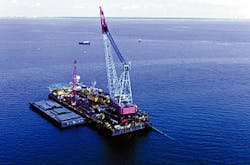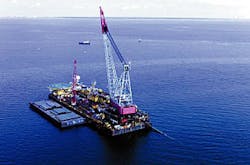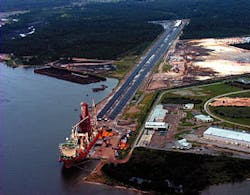GOM shelf project nears completion
Pipelay for Williams Cos. Inc.'s East Breaks project offshore Texas in the Gulf of Mexico achieved a high lay rate in its activity in late spring and summer, according to Stolt Offshore Inc., lay contractor for the project.
On June 28, derrick lay barge DLB 801 achieved its highest lay rate of 327 joints/day on 24 in., 0.562-in. WT pipe, laying pipe in the shallow water portion of the project.
For the deepwater portion of the system, Coflexip Stena Offshore's CSO Deep Blue Sea is installing export pipelines from fields in 3,700-ft water.
Automatic welding
Stolt received the multimillion-dollar contract from Williams in January. The shallow water portion of the deepwater Boomvang-Nansen Seahawk system, the pipeline will gather gas production from deepwater spars.
The East Breaks pipeline project involved installation of 58 miles of 24-in. pipe from Brazos Block 538 in 97 ft of water to Galveston Block A244 in 365 ft of water. At the end of last month, Stolt performed riser tie-ins at the existing Brazos Block 538 platform and a pipeline tie-in at Galveston Block A244 following platform installation.
Mobilized earlier in the year from offshore West Africa, the DLB 801 began pipelay in late May and, after tropical storm Allison moved out of the gulf, quickly ramped up to more than 250 joints/day, said Stolt. The vessel used Stolt's Saturnax automatic welding system, a technology new to the Gulf of Mexico.
The Saturnax is a dual-torch gas metal-arc welded bug-and-band system whose dual-torch process doubles the rate of metal deposition, says Stolt, allowing the highest production rates with half the number of welding stations.
Moreover, the dual-torch process, through the annealing effect of the second torch, increases the toughness of the weld while diminishing the hardness. The same Saturnax bugs can be used on 6-in. OD and larger, says the company.
Each Saturnax welding station involves one dual-torch bug on either side of the pipeline, or two if the diameter and welding cabin or barge tunnel allow. All the welding passes are deposited from the outside of the pipe, using the same shielding gas. Because all the Saturnax bugs are identical, said Stolt, each welding station, if necessary, can complete one weld from root to cap.
For much of its work from mid-June through July, the DLB 801 used an eight-point mooring spread to maintain a steady lay rate of 260-300 joints/day with only three welding stalls on the project.
Stolt's Seaway Defender dynamically positioned vessel performed the tie-ins, employing saturation diving at the Galveston A244 location.
For the balance of the project, Stolt trenched the shallow end of the new pipeline up to the 200-ft contour line with the company's Horizon Offshore Canyon Horizon jet barge trenching 37 miles of the pipeline to 3 ft below natural bottom.
Stolt said in September that it anticipates the large-diameter project may be the first of many in the gulf as the industry readies to improve infrastructure to accommodate deepwater production.
Deepwater source
Laying the deepwater portion of the system is Coflexip Stena Offshore's CSO Deep Blue. The reel pipelay vessel is currently installing the export pipelines from the Boomvang and Nansen fields on East Breaks Blocks 643 and 602. The lines run inshore to the production platform in 365-ft water on Galveston Area Block A244.
The contract work scope for the vessel includes the installation of more than 100 miles of rigid pipeline and steel catenary risers (SCRs) with diameters ranging 12-18 in. and tie-in to the fields spar platforms using SCRs.
The vessel started operating from CSO's newly established rigid pipe spoolbase in Mobile, Ala., said the company, after successful deepwater pipelay trials in the Atlantic Ocean and North Sea.
CSO said the base supports offshore pipelay and construction work in the Gulf of Mexico by providing for assembly, storage, spooling, or loading of rigid pipelines before installation in deepwater by the two CSO reelships, CSO Deep Blue and CSO Apache.
The company said that in 2002-2003, CSO Deep Blue will continue deepwater operations by working on Na Kika for Shell Exploration & Production Co. and achieve several records. The vessel will install the deepest ever pipe-in-pipe system using J-Lay, the deepest ever fully reeled SCR, and the deepest ever pipe-in-pipe SCR.
The six-field development is on Mississippi Canyon Block 474 in 5,800-7,000 ft of water (OGJ Online, June 26, 2001).
null
null


